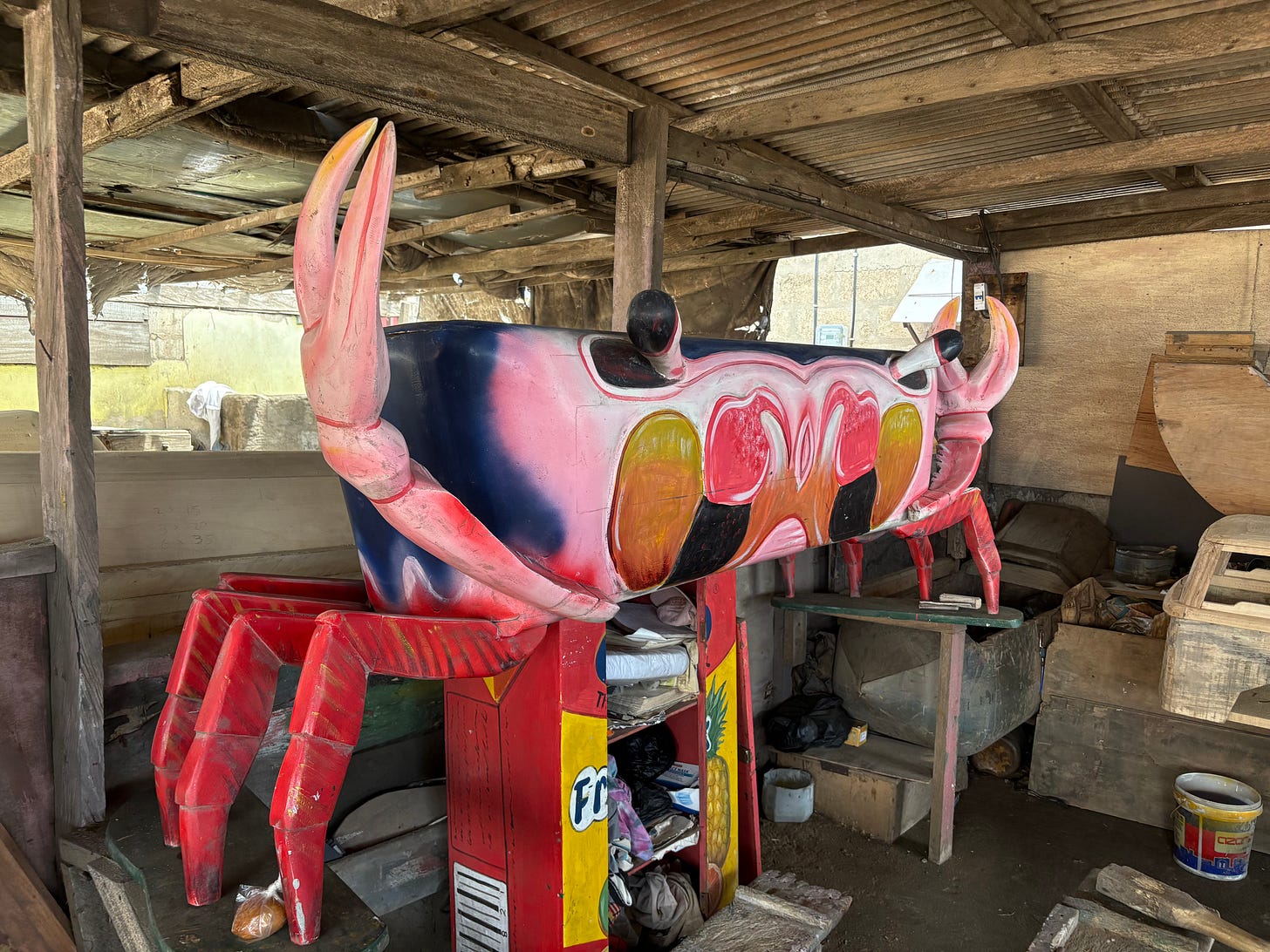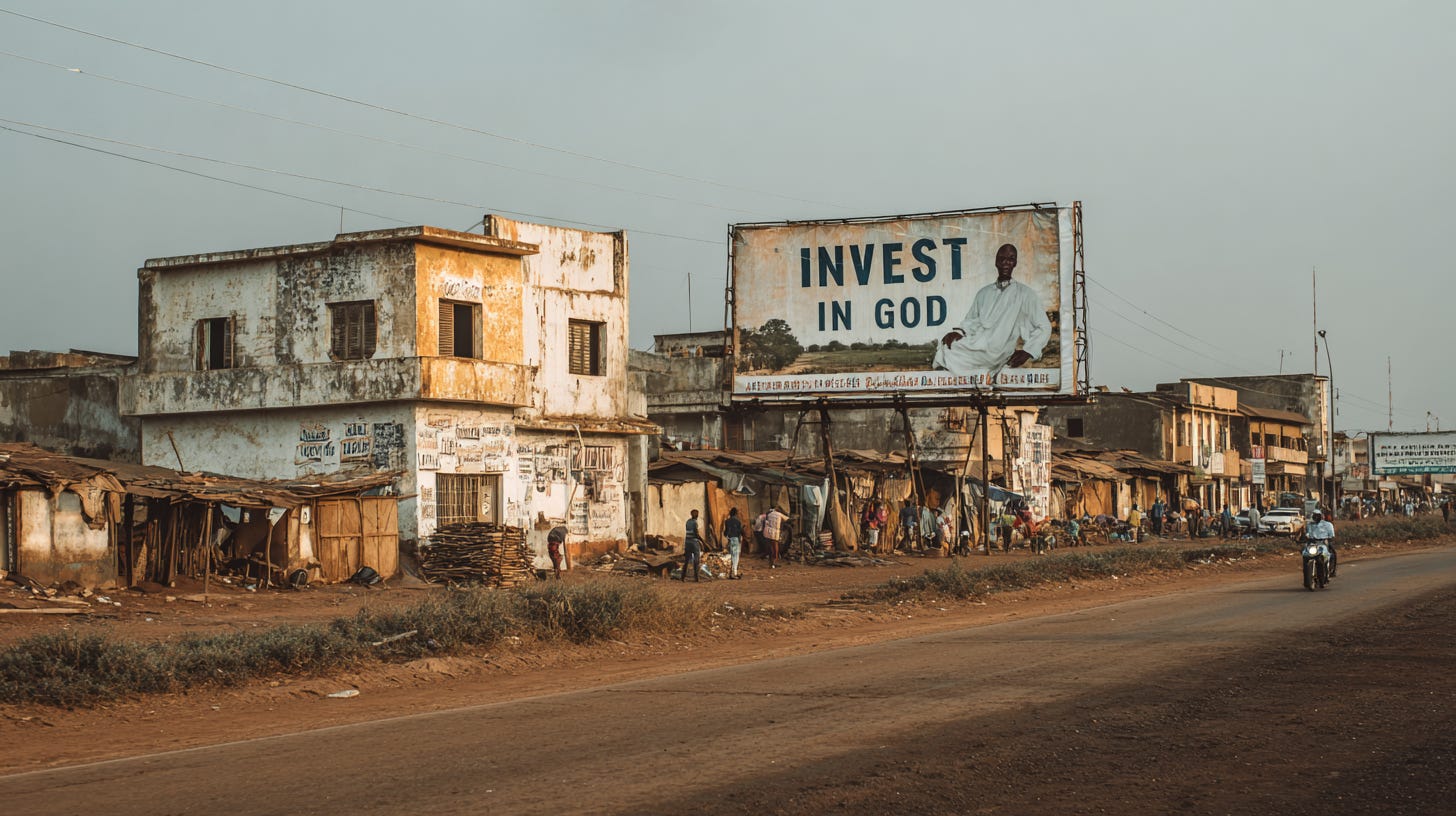The cost of belonging
Why costly rituals and adaptive churches thrive where the state is thin
On a recent trip to Accra, I ventured out of my hotel to visit a coffin maker. Ghana is known for its elaborate burial ceremonies and its ‘fantasy coffins’: caskets in the shape of a fish, a mobile phone, or – my favourite – a crab. I asked the craftsman what they sell for. He said the local ones, made with local wood, go for about $1,000; the ones for export, requiring imported wood, are $4,000 or more. Consider that Ghana’s GDP per capita is a little over $2,000. Why, it must be asked, do Ghanaians spend almost half their average annual income on a fast-perishable coffin?
This is the question I recently asked Paul Seabright, author of The Divine Economy: How Religions Compete for Wealth, Power, and People, on the Our Long Walk podcast. His answer begins with signaling:
The whole point about signaling… goes back to Thorstein [Veblen] who talked about wasteful expenditure as a signal of the ability to afford it.
Its pointlessness is the point… there is something in your face about saying: we can afford to spend a lot of money on a beautiful object which will go underground and rot.
If you are accompanying somebody very dear to you, then making a gesture of something which perishes with them is actually one of the finest and noblest things you can do… We put flowers… because we’re not going to see them again.
When I and my colleagues offered insurance to people against future funeral expenditure, it’s clear they found that very valuable… they don’t like the thought of having to do it, even if, faced with the deceased of the person that is close to them, they don’t hesitate for a second.
What looks like ‘waste’ can, in economic terms, be understood as a signal of solidarity. And it is not the only way religion is shaping Africa’s economies today. A recent NBER paper by Sara Lowes, Benjamin Marx and Eduardo Montero argues that religiosity has not receded in developing regions in the way that classic theories of secularisation predicted. The reason is that religion adapts to social and economic conditions. It helps people manage risk, provides meaning when institutions are fragile, and supplies services where the state is absent.
The authors document the divergence clearly. Survey data over the past four decades show that while belief and church attendance have fallen in Europe and North America, they have remained stable, even rising, in much of Africa, Asia and the Middle East. In sub-Saharan Africa, formal Christianity and Islam coexist with traditional beliefs about ancestors, witchcraft and spirits. These are not archaic survivals but active systems of meaning that help people navigate uncertainty. Religion, it turns out, is continually reinventing itself to meet needs that governments and markets often fail to provide.
Seen this way, the exuberant coffins of Ghana are less a puzzle than part of a wider pattern. They are costly signals that reinforce community at moments of vulnerability. The same mechanism explains the popularity of prosperity churches, healing crusades and prayer camps. Religious institutions are platforms that supply both spiritual reassurance and tangible support. They flourish because they adapt.
A second NBER paper by Eduardo Montero, Dean Yang and Triana Yentzen provides a sharper test of this idea. It studies the Seventh-day Adventist Church, which prohibits members from producing tobacco, coffee or tea. In regions where those crops are lucrative, joining the church means forgoing income. Using detailed crop-suitability maps and global price data, the authors calculate the opportunity cost of belonging, year by year, across sub-Saharan Africa. The results show that when the price of those prohibited crops rises, church membership growth slows. People hesitate to join when the economic sacrifice is too great.
But institutions adjust. Local Adventist churches invest more in schools and clinics, offsetting the costs of adherence with new benefits. They also soften their messages on ‘healthy living’. Members in high-cost areas report hearing less about strict prohibitions and are more likely to admit to tobacco or alcohol use. Satisfaction and long-term commitment fall. What is clear is that religious organisations do not hold doctrine rigidly when economics shifts. They bend at the margins to maintain members. Adaptation is not incidental; it is central to their growth.
What does this imply for development? A 2024 survey in the Journal of Economic Literature by Sascha Becker, Jared Rubin and Ludger Woessmann provides a framework. Religion, they argue, influences growth through the familiar inputs of any economy: capital, labour, skills and technology. It can foster thrift, trust and human capital, but it can also divert resources, constrain inquiry and limit innovation. Its effect is conditional, varying by context and channel.
Consider human capital. Religious institutions have often been central to the spread of schooling in Africa, from nineteenth-century missions to today’s faith-based schools. Yet they can also reinforce boundaries or limit curricula. As Olúfẹ́mi Táíwò put it in another Our Long Walk conversation, African universities risk becoming subordinated to religious authority rather than engines of scientific progress. ‘Africa is the only continent where there’s no imprint of the scientific revolution. Only the universities could make that happen. They’re not doing that.’ For him, the growing influence of religious-chartered universities is a profound obstacle to modernisation.
The thread that runs from Ghana’s coffins to Africa’s universities is the same: religion adapts to economic pressures, but it also sets boundaries. It binds communities and provides services, yet it can also slow the advance of reason and science.

Three lessons follow. First, what appears as waste can in fact be social capital. Costly rituals help insure and dignify. Economists should resist the temptation to see them only as inefficiency. Second, religious institutions are adaptive suppliers. When the price of adherence rises, they invest in substitutes. That makes them potential partners for governments, especially in education and health. Third, religion can constrain growth, particularly when it crowds out science. The challenge is to design institutions that engage with faith where it helps and protect the autonomy of knowledge where it hinders.
Religion, as I’ve pointed out before, is as much as about economics as it is about faith. The economics of religion in Africa is, in this sense, the economics of how communities insure, educate and organise themselves when the state is thin and modernity uneven. The fantasy coffin is not only a work of art or a symbol of faith. It is also a reminder that people will spend real resources on the things that bind them.
This is an edited and translated version of my monthly column, Agterstories, on Litnet. To support more writing like this, consider becoming a paid member. The image was created using Midjourney v7.




Ancestor worship? Pyramids?